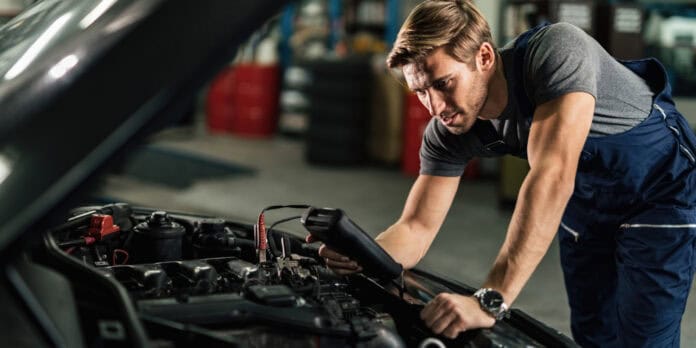Table of Contents
A healthy car battery is vital in starting and powering vehicle systems. If it dies, you can find yourself inconveniently broken down in your driveway or a parking lot. However, if you know how to check your car battery life, you can avoid these instances and help detect issues before they arise.
1. Check the Voltage
The first step is checking your battery’s voltage. Turn off your car, open the hood, and use a multimeter or voltmeter set to a 20V DC range. Remove the terminal covers and connect the positive probe of your multimeter to the red terminal. Then, connect the negative probe of your multimeter to the black terminal.
What does the voltage display say? If it’s showing a voltage of 12.6V or higher, you can rest assured that it is fully charged. If the reading is between 12.2 V and 12.4 V, your battery is about 50-75% charged. And if you see a reading of 12.0V or less, it needs to be charged.
2. Perform the Headlight Load Test
The headlight load test is straightforward and has just a few steps. It can help you understand where your battery health lies without the need for any specific tools.
Park your car in a dark area, turn on your high-beam headlights, but don’t turn the engine on, and allow the headlights to stay on for about 10-15 minutes. Pay attention to how bright the lights are. Then, turn your car on.
The battery is weak if the car’s initial brightness dims significantly when it is turned on. If it fails to start, the battery is dead or extremely weak. A healthy battery can handle 10-15 minutes of light power before the engine turns over, and the light will remain bright.
3. Look at the Battery Health Indicator
Check if your car includes a built-in health indicator. It’s usually a small circular window on top of the car’s battery. You’ll notice a colour indicator, so you must know what each colour refers to.
A green colour indicates good condition, while a black or dark colour means it needs charging. Clear or yellow indicates the need for a new battery.
While this isn’t a feature available on all models, it can be helpful if you have it and the other tests haven’t been indicative.
4. Physical Check
When in doubt, you can always check yourself with a visual inspection. What should you look for? Corrosion signs include white, green, or blue deposits on the terminals. Swelling is also a bad sign that would be evident through bulging sides on the case. Finally, check for leaks caused by cracks in the case, puddles beneath the battery, or wet spots.
Confirm the battery’s age by looking at the label and finding the manufacture date. Most batteries last 3-5 years, so ensure it falls within that time frame.
What About EVs?
If you drive an electric vehicle with a low or dead battery, use an EV charger to get it back to full capacity. If you don’t have an EV charger available, you can also use reserved energy from EcoFlow Portable Power Stations, solar panels, or propane/gas from the EcoFlow Smart Generator (Dual Fuel).
The EcoFlow DELTA Series Portable Power Stations, including the EcoFlow DELTA Pro, are effective backup options to charge your EV battery when you’re away from home and public charging stations.
Frequently Asked Questions
You can check the health of your car battery using several methods, including a voltage check, load test, and visual inspection. You can also take your car into a shop, where they’ll use professional testing options like computerised tests.
Signs of health include a well-held charge, no physical damage, and a car that starts consistently. Red flags that your battery is weak, damaged, or dead include a slow engine crank, frequent need for jump-starts, and other electrical issues.
If you don’t have a tester, you can still check your car battery life using a health indicator, load test, or visual inspection. Just know that DIY testing will not be as accurate as professional tests and may miss underlying issues.
Final Thoughts
Regularly checking your battery health will give you peace of mind as you drive, prevent unexpected breakdowns, and extend its lifespan. While the above steps provide great DIY options, you should seek professional help if you repeatedly get inconsistent results, face repeated charging issues, or your battery is over three years old.
And if you have an EV, remember that backup power solutions like portable power stations can save you when you’re caught with a low battery far from home and public charging stations. EcoFlow’s Portable Power Stations are fantastic options that are versatile enough for your car and home.


